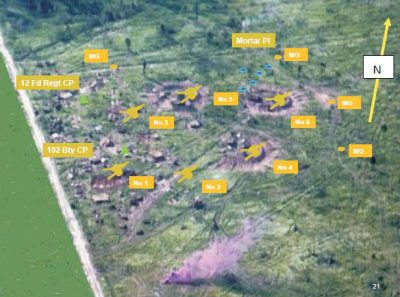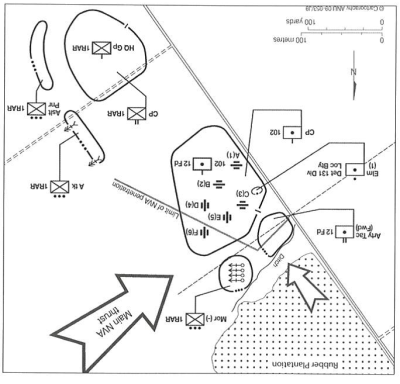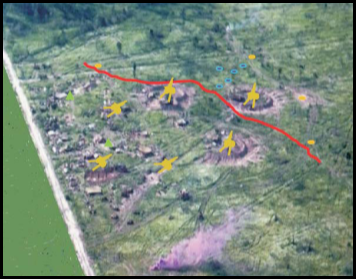1RAR Mortar Platoon arrived at FSPB Coral at 5.00pm, around one hour short of last light. The late arrival of the 1RAR Mortar Platoon severely reduced the amount of time they had to prepare their weapons pits and establish their defensive fire positions before last light.[1] Lieutenant Tony Jensen was met by Captain Hugh McInally and was taken to the Mortar position. McInally apologised that the 1RAR Mortars were situated on the perimeter of the 102 Field Battery gun position and told Jensen ‘it will get sorted tomorrow.’[2] The 1RAR Mortars were positioned 50 to 70 metres out, slightly in front of and located between No. 5 and No. 6 guns.[3] Jensen approached Murtagh and asked where everybody was and what was going on.
Murtagh informed me that 3RAR was about somewhere providing protection and waved his arms in the general direction of the rubber plantation. I asked about manning machine guns and was told by Murtagh it was not necessary. I stated that my men were only just in country,[4] and we should man a machine gun sentry, yet Murtagh was not interested.[5]
With 102 Field Battery and 1RAR Mortars being further north than planned, the discovery of enemy weapons pits, and Murtagh’s dismissive attitude of the situation regarding defences, added responsibility was placed upon Ahearn and Jensen. The two Lieutenants now had to establish defensive fire positions for the machine guns. A task that was the responsibility of Murtagh, who failed to conduct more than one of his roles as the FSPB defence commander.
Two Final Preventative Fire Tasks
The Official history states that, at 6.09pm, 3RAR viewed multiple enemies moving across their front. Shortly after, 1RAR engaged 10 enemy soldiers. As a result of the enemy contacts, 102 Field Battery was called to provide a fire mission.[6]An omission in the Official History is the conversation between Battery Commander Major Gavin Andrews and Lieutenant Ian Ahearn that centred on two Final Preventative Fire tasks. The result had a significant impact on the battle that was to occur at FSPB Coral.
In the early hours on 13 May, 102 Field Battery was called to provide supporting artillery for the infantry. The six artillery guns that were originally pointing east were manoeuvred by their gun crews and pointed north. The guns then delivered their 105mm projectiles with deadly accuracy. The fire mission lasted 20 minutes before the six artillery guns were advised that the mission had ended.[7]
With all six artillery guns now pointing north, Andrews asked Ahearn if the gun battery could handle two Final Preventative Fire tasks.[8] A Final Preventative Fire task is one battery (six guns), loaded with information on a target, normally selected as the most probable area of enemy activity. The artillery gunners only need to pull the lanyard to fire the gun and the projectile will land where assigned. Andrews wanted one section (three guns) laid north and one section returned to its original eastern bearing. Ahearn selected guns (No. 4, 5 and 6) to stay pointing north and the other three (No. 1, 2 and 3) to be laid on the original east bearing.[9] (See Figures 1.5 and 1.6).

Figure 1.5: The six 102 Field Battery M2A2 105mm howitzer guns (yellow), 1RAR Mortar Platoon (blue circles), machine gun positions (yellow circles), 12 Field Regiment Command Post and 102 Field Battery Command Post (red triangles).[10]
Figure 1.6: Positioning of No. 1, 2 and 3 guns after they returned to the original eastern direction. Note: Red line indicates enemy penetration.[11]
Ahearn provides his reasoning for selecting the guns:
Now a bit of serendipity went on here for no reason at all as I picked the three guns to the north as they were already bunded, before we had to stop work as last light was approaching and we had to stand to.[12]
The use of Splintex
The Official History states that Jensen, in desperation, called for direct fire from the Anti-tank Platoon’s 90mm Recoilless Rifles. Splintex was fired across the front of the mortar position, providing some relief for the 1RAR Mortars.[13] The veterans interviewed reject the action as being an inaccurate account of what happened.
At around 2.30am, the mortar position was under fire from small arms and RPG’s. Jensen and his men were being overrun. 3RAR Mortars and 161 Field Battery was called to fire on Jensen’s position as the enemy was swarming through them. The Operations Officer, Kim Patterson, asked Jensen three times for the fire order to be repeated. Each time Jensen did just that. Finally, Jensen held his radio hand piece up so Patterson could hear the contact, hoping this would convince Patterson of the severity of the situation. Jensen’s only option was to call in a fire mission.[14] Jensen recalls:
We had to hold our ground and do what we could and the only way we could do that was to call in a fire mission on our position which is what I organised.[15]
After some discussion between the Mortar Command Post and the Battalion Headquarters, the Commanding Officer (Bennett), agreed to have splintex fired over the mortar position.[16] With Murtagh in effect absent throughout the battle, Bennett, although not in command of FSPB Coral (along with his Battery Commander and Headquarters staff) authorised Jensen to have 102 Field Battery fire across their position.[17] As Jensen recalls:
I told the men to stay in their pits, engage the enemy, but do not get above ground level as anything above ground was considered enemy. I repeated to Command that we have a contact, we are overrun and we need fire over our position, it is the only way to clear them.[18]
Since dawn, Ahearn had been trying to contact Jensen to ascertain if he and his men were indeed alive. He eventually managed to get him to answer by voice. This created another problem as each time Ahearn, positioned near No. 5 gun, called Jensen, who was positioned between No. 5 and No. 6 guns, both were met with a volley of enemy machine gun fire.[19] Ahearn returned to the Command Post to hear Jensen on the Battalion radio asking for splintex to fire across his position. Jensen, bluntly stated, ‘if you don’t do it then we are all dead’.[20]
Ahearn recalls:
Jensen was trying to convince his CO [Commanding Officer] that they were in real deep shit [sic] and the CO sort of said are you sure? Christ I don’t know what he thought was going on because I was told later that it looked like Luna Park with all the RPG’s and machine gun fire coming in.[21]
To comply with Jensen’s call, Ahearn returned to No. 5 gun and informed the gunners to aim the gun across the mortar position.[22]
Ahearn continues:
I yelled out to Tony [Jensen], asked if he was ready, he yelled at his guys to stay down and he said let it rip. We fired five rounds of splintex across the top of the mortar section and all enemy activity ceased. The mortars were only 50 metres off the guns and all activity just stopped and we thought, Holy Christ I wonder if we had just killed them.[23]
Jensen adds;
Scrubber [Ahearn] yelled out to me that they were going to fire splintex, so I said right and told the platoon what was going on and basically get underground as splintex was coming in. I gave two warnings and the third time I said right fire and Scrubber fired and everything went sort of quiet.[24]
Lance Corporal Alan James (Jack) Parr was Jensen’s signaler and looked after two radio sets. One was connected to the Battalion command network, the other used for commanding mortar fire missions. With FSPB Coral overrun, Parr called in direct fire support from 3RAR Mortars, a Light Fire Team of two helicopter gunships and a ‘Spooky’ gunship. Parr deliberately called fire onto his very own position in an attempt to kill the enemy and save his mates. One metre way in the other fighting pit, Jensen called in direct fire from 102 Field Battery.[25]
As Jack Parr recalls:
The guns fired HE [High Explosive] and splintex rounds making an awesome sound coming through one’s own position. These [splintex darts] were lodged everywhere in equipment and weapons…millions were fired into and across our positions in an attempt to clear the enemy.[26]
Other evidence corroborates the men’s version of the event, showing that, despite the Official History’s claim, it was not the Anti-tank Platoon’s 90mm Recoilless Rifles that fired splintex across the front of the 1RAR Mortar Platoon.[27] Figure 1.7 indicates the positioning of all three units involved, and clearly shows that the 1RAR Mortar Platoon was partially protected by the 102 Field Battery guns. If the 90mm Recoilless Rifles did fire across the front of the Mortars, then 102 Field Battery would have been hit with splintex. This would have resulted in serious injury or death to the gunners.

Figure 1.7: The positioning of 1RAR Mortars, 102 Field Battery, and the 90mm Recoilless Rifles on the night of 12-13 May 1968.[28] Note: The black line indicates the firing direction of the splintex round as mentioned in the Official History.
The strongest evidence, however, that corroborates the veterans’ version of the use of splintex is in the After Action Report, a source readily available to the Official Historians. It clearly states that the gunners from 102 Field Battery engaged the enemy with splintex rounds by firing over the 1RAR Mortar Platoon’s position. It also recorded the time, which matches the recollections of the men (see Figure 1.8).[29]

Figure 1.8: The After Action Report clearly Indicates that, Gunners from 102 Field Battery were able to engage en (enemy) with HE (High Explosive) and splintex rounds and fired over the Mor Pl posn (Mortar Platoon position). The time indicated in the top left corner is 0425 hours (4.25am).
Close Quarter Fighting
Despite the fact that the enemy launched an effective surprise attack on FSPB Coral, and failed to over-run it, and that the fighting over 12 and 13 May was intense, the men from 102 Field Battery and 1RAR Mortar Platoon feel that the Official History obscures, or overlooks, their role and actions during those eventful days at FSPB Coral. This has disappointed the Coral veterans interviewed, and they question just how ‘official’ the Official History is. Close Quarter Fighting provides the soldiers’ voice and offers an insight into what the gunners and mortarmen remember about FSPB Coral.
With the 102 Field Battery guns arriving at Ahearn’s position, he immediately informed the gunners that something was amiss, but was unsure as to what it was. He therefore directed the soldiers to dig to stage one weapons pits.[30]
This made Ahearn very unpopular as he remembers.
Some will say that they only had shell scrapes, and they might well have, but we as Officers had to go around and kick ass to make sure that people were digging. I think that shows in the results as you don’t get a number of RPG’s and things in without having excessive casualties.[31]
On 12 May, no defence stores had been delivered to FSPB Coral. With no barbwire, claymore mines or trip flares set up, the area lacked adequate protection. When the attack came, Ahearn was lying in his weapon pit. There was no sound, but he was awoken by a green glow over his hootchie (personal tent), a result of enemy tracer coming into FSPB Coral.[32]
Literally there was no sound; I didn’t hear anything until it came in like a ‘whomp’, it was the sound of RPG’s, mortars and machine guns.[33]
At this early stage of the battle, No. 6 gun was out of action as it had been overrun by the enemy. Gun Sergeant Max Franklin, however, had had the presence of mind to remove the No. 6 gun firing pin before withdrawing. This is a difficult task that requires a series of moves, and made all the more difficult by being under attack and with wounded men under his command. Sergeants Franklin’s actions made the 105mm Howitzer inoperable in enemy hands. Ahearn quickly made his way to the Command Post to find out what was happening.[34]
At this stage, No. 4 gun opened fire with small arms (rifles) and shortly after, the Gun Sergeant John Stephens reported to the Command Post that they had expended small arms ammunition and requested an ammunition resupply. The Gun Sergeant also reported that there was a considerable amount of activity happening at No. 4 gun and requested permission to fire the 105mm howitzer over open sights.[35]
As a result of the close quarters’ fighting, 102 Field Battery had suffered casualties. Supporting fire was called for and was delivered by 161 Field Battery, 3RAR Mortars and an American Battery located in and around Bien Hoa. The Battery Commander also arranged for Cobra gunships and a ‘Spooky’ gunship to assist in the fight and they began to pound the perimeter of FSPB Coral.[36]
At FSPB Coral, Jensen sighted the mortar tubes and told the section commanders to dig in and get organised before he and Signaler Parr started digging the command post and sleeping bay.[37] The mortars had approximately 75 mortar rounds each and were supported by two machine guns. By last light the mortar pits and the command post had been prepared.[38] At midnight, NVA soldiers engaged the 1RAR Mortar machine guns. The machine gunners fired back. There were moans and groans from the enemy and then they fell silent. The mortars remained alert for another half an hour and at 12.30am they returned to their positions. At around 2.30am, the enemy came through the mortar position ‘in no time flat’.[39] Everything was happening very fast, enemy and small arms fire was all through the mortars, as Jensen recalls.
There were 18 men in the Mortar Platoon and we were like a pimple on the side of the gunners and when they (NVA) came through, we basically surprised them and that created a bit of a problem as they didn’t expect us to be there. On top of that, we held our ground and fought hard.[40]
Click Here for Part 3
[1] Tony Jensen (interview conducted, 17 February 2013), p. 1.
[2] ibid.
[3] ibid.
[4] ibid., pp. 1-2. Note: In country means that the soldiers had only recently arrived in Vietnam.
[5] ibid.
[6] McNeill and Ekins, On the Offensive, p. 364.
[7] Ian Ahearn, ‘South Vietnam: First Battle of Coral 12th – 13th May 1968 The Real Story’, Journal of the Royal Australian Artillery Historical Company, no. 84 (2012), p. 13.
[8] ibid., p. 17.
[9] Ahearn, p. 4.
[10] Ahearn, ‘South Vietnam: First Battle of Coral 12th – 13th May 1968, p. 17.
[11] ibid.
[12] Ahearn, p. 4.
[13] McNeill and Ekins, On the Offensive, pp. 367-368.
[14] Jensen, p. 2.
[15] ibid., p. 3.
[16] ibid.
[17] Robert Lowry, The Last Knight: A biography of General Sir Phillip Bennett AC, KBE, DSO, (Newport: Big Sky Publishing, 2011), p. 95.
[18] Jensen, p. 2.
[19] Ahearn, p. 6.
[20] ibid.
[21] ibid.
[22] ibid., pp.6-7.
[23] ibid., p. 7.
[24] Jensen, p. 3.
[25] Australian War Memorial, Splintex Dart, Battle of Coral: Lance Corporal A J Parr, 1 Battalion Royal Australian Regiment, http://www.awm.gov.au/collection/REL35838 (accessed 15 February 2014).
[26] ibid.
[27] McNeill and Ekins, On the Offensive, pp. 367-368.
[28] Lowry, The Last Knight, p. 94.
[29] Australian War Memorial, Australian Army Commanders’ Diaries (Vietnam), Infantry Units, 1 Battalion Royal Australian Regiment, Narrative, Annexes (1-30 June 1968), AWM95-7-1-79, http://www.awm.gov.au/collection/records/awm95/7/1 (accessed 11 November 2013), p.48.
[30] Ahearn, p. 3.
[31] ibid.
[32] ibid.
[33] ibid., p. 4.
[34] ibid.
[35] ibid., p. 5.
[36] ibid., p. 6.
[37] Jensen, p. 1.
[38] ibid., pp. 1-2.
[39] ibid.
[40] ibid., p. 3.
Contact Mark Jamieson about this article.







